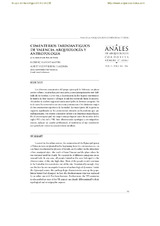Cementerios tardoantiguos de Valencia: arqueología y antropología

Ver/
Autor
Ribera i Lacomba, Albert Vicent
Alapont Martín, Llorenç
Editor
Universidad de Córdoba, Área de ArqueologíaFecha
2006Materia
AntropologíaYacimientos funerarios
Arqueología
METS:
Mostrar el registro METSPREMIS:
Mostrar el registro PREMISMetadatos
Mostrar el registro completo del ítemResumen
Located in the urban center, the cemeteries of the Episcopal group of Valencia were originated in the beginning from two circumstances, on one hand, to a hierarchic process of burials, on the other, to the attraction of two martyrial sites : the tomb of Saint Vincent and the place where he was tortured until his death. Two necropolis of different categories arose around both. In any case, all people buried in this area belonged to the diverse status of the city high class. Most of the people would continue to be buried in the cemeteries out of the city. Paradoxically enough, they are the less known necropolis because of archaeological dynamics. Inside the Episcopal center, the anthropologic characteristics among the population buried had changed. In fact, the Mediterranean type was replaced by an other one with Northern features. Furthermore, the V-VI centuries tombs and other ones of the VII century are clearly differentiated by their typological and stratigraphic aspects. Los diversos cementerios del grupo episcopal de Valencia, en pleno centro urbano, respondían, por una parte, a una jerarquización muy definida de las tumbas, y, por otra, a la atracción de dos lugares martiriales: la tumba de San Vicente y el lugar donde fue torturado hasta la muerte. Alrededor de ambos surgieron sendas necrópolis de distinta categoría. En todo caso, los enterrados en esta zona pertenecían a los distintos rangos de los estamentos superiores de la ciudad. La mayor parte de la gente se seguiría sepultando en los cementerios situados en la periferia que, paradójicamente, son menos conocidos debido a la dinámica arqueológica. En el centro episcopal, los rasgos antropológicos entre las tumbas de los siglos V-VI y las del s. VII, bien diferenciadas tipológica y estratigraficamente, indican un cambio poblacional, al sustituirse el tipo mediterráneo grácil por otro con características nórdicas.
